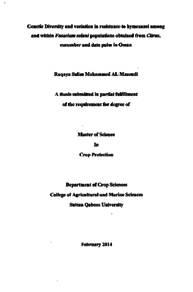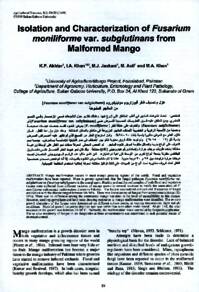وثيقة
Gentic diversity and variation in resistance to hymexazol among and within fusarium solani populations obtained from citrus, cucumber and date palm in Oman
الناشر
Sultan Qaboos University
ميلادي
2014
اللغة
الأنجليزية
الملخص الإنجليزي
A study was conducted to investigate diversity among 80 Fusarium solani isolates obtained from date palm (30), citrus (31) and cucumber (19). Characterization based on sequences of the EFla and ITS rDNA genes of the 80 Fusarium solani isolates showed grouping of the isolates in two major clusters, with no relationship with the host or geographical origin from where the isolates were obtained. AFLP analysis using 3 primer pair combinations produced 980 polymorphic and 80 AFLP genotypes. Populations from different hosts and districts showed moderate levels of genetic diversity (H= 0.2494). Clustering of the isolates was not related to host or geographical origin of the isolates. This was supported by analysis of molecular variance (AMOVA) which Un indicated the existence of low level of genetic differentiation among populations obtained from different hosts (Fst = 0.0162) and regions (Fst=0.0066). F. solani isolates displayed variation in sensitivity to hymexazol, with ECso values ranging from 2 to 5745ug mil (meán = 878 ug ml,'). This implies the existence of resistance to hymexazol among F. solani isolates in Oman. The study provides evidence for frequent movement of F. solani inoculum among hosts and regions in Oman, which could be attributed to cultural practices employed by farmers. Growers should move towards the use of integrated disease management strategies to avoid further development mers. em of resistance to hymexazol.
المجموعة
URL المصدر
الملخص العربي
أجري هذا البحث لدراسة تنوع 80 عزلة من فطر فيوزاريوم سولاني معزولة من أشجار النخيل (30 عزلة) ، الحمضيات (31 عزلة ) و الخيار (19 عزلة). عند توصيف ال 80 عزلة من الفيوزاريوم سولاني اعتمادا على دراسة تسلسل القواعد الوراثية لمنطقة عامل الاستطالة ألفا 1 (EF1a) ومنطقة الأي تي أس في الحامض النووي الريبوزي (ITS rDNA) أظهر التحليل الى تقسيم العزلات إلى مجموعتين رئيستين ، مع عدم وجود علاقة مع العائل أو المنشأ الجغرافي. تم استخدام تحليل البصمة الوراثية (AFLP) وذلك باستخدام ثلاثة بادئات (primers) حيث أنتج التحليل 980 موقع جيني مختلف و 80 صنف جيني . كشفت الدراسة عن وجود مستوى معتدل من التنوع الجيني ( 0. 2494 =H) للفطر المعزول من مختلف النباتات والمناطق، كما لم يلاحظ اي ارتباط بين التنوع الجيني والعائل او المنشأ الجغرافي. أثبتت هذه النتيجة حسب تحليل (AMOVA) إلى وجود مستوى منخفض من الاختلاف الجيني بين عزلات الفطر المعزول من النباتات ( 0 . 0162=Fst ) والمناطق المختلفة ( 0. 0066=Fst)، كما أظهرت عزلات فيوزاريوم سولاني تنوعا في الحساسية لمبيد hymexazol ، حيث تراوحت قيم التركيز الفعال النصفي (ECs0) بين 2 إلى 5745 ميكروغرام /مل (المتوسط = 878 ميكروغرام /مل)، مما يدل على وجود مقاومة لمبيد hymexazol بين عزلات فيوزاريوم سولاني. كشفت هذه الدراسة أدلة على حركة فطر الفيوزاريوم سولاني بين مختلف النباتات والمناطق في سلطنة عمان ، والتي يمكن أن تعزي إلى طبيعة الممارسات الزراعية التي يستخدمها المزارعون. ينصح المزارعون باستخدام استراتيجيات المكافحة المتكاملة لتجنب تطور المقاومة لمبيد hymexazol.
قالب العنصر
الرسائل والأطروحات الجامعية


